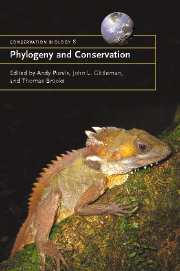1 - Phylogeny and conservation
Published online by Cambridge University Press: 04 December 2009
Summary
WHY A BOOK ON PHYLOGENY AND CONSERVATION?
Of the many sub-fields of biology, phylogenetics and conservation biology are two of the fastest growing. On the one hand, the explosion of phylogenetics – the study of evolutionary history – has been stimulated over the past two decades by the emergence of new molecular methods and statistical techniques for modelling the tree of life. DNA sequence data are now typically freely available through public-access databases such as GENBANK, and much software for phylogeny estimation is cheap and easy to use. On the other hand, the tree of life is being heavily pruned by human activities; this pruning has helped to drive the emergence of the applied discipline of conservation biology.
Bibliometric data provide a rough-and-ready way to summarise the growth in the two disciplines. There was an exponential increase in the number of papers in both fields between 1992 and 2003, as shown by a search of the Science Citation Index with the keywords ‘conservation biology’ and ‘phylogen*’. According to these searches (other terms would give slightly different results), numbers of papers in each discipline are growing at about 12%. The growth rate of the intersection set – papers linking conservation biology and phylogenetics – is slightly (although non-significantly) lower at 10.4%. Numbers of papers found by a search for ‘phylogen*’ in four conservation journals (Conservation Biology, Biological Conservation, Biodiversity and Conservation and Animal Conservation) over the same period have increased at about the same rate (13%) as phylogenetics papers overall.
- Type
- Chapter
- Information
- Phylogeny and Conservation , pp. 1 - 16Publisher: Cambridge University PressPrint publication year: 2005
References
- 3
- Cited by



